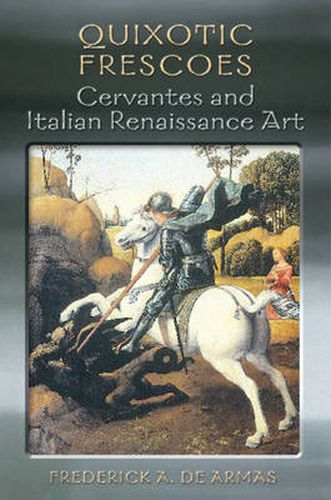Readings Newsletter
Become a Readings Member to make your shopping experience even easier.
Sign in or sign up for free!
You’re not far away from qualifying for FREE standard shipping within Australia
You’ve qualified for FREE standard shipping within Australia
The cart is loading…






As a young man, Miguel de Cervantes left his home in Spain and travelled extensively through Italy, experiencing all that the Italian Renaissance had to offer. In his later writings, Cervantes sought to recapture his experience through literature, and literary critics have often pointed to Italian texts as models for Cervantes’ writing. The art of the period, however, has seldom been examined in this context. Focusing on Don Quixote, Frederick A. de Armas unearths links between Cervantes’ text and frescoes, paintings, and sculptures by Italian artists such as Cambiaso, Michelangelo, Raphael, and Titian. His study seeks to re-engage the critics of today by formulating the link between Cervantes and the Renaissance through an interdisciplinary dialogue that establishes a new set of models and predecessors. This dialogue is used to explore a variety of issues in Cervantes including the absence of a single guiding pictorial program, the doubling of archaeological reconstruction, and the use of ekphrasis as allusion, interpolation, and an integral component of the action. Quixotic Frescoes delves into the politics of imitation, self-censorship, religious ideology expressed through the pictorial, as well as the gendering of art as reflected in Cervantes’ work. This detailed and exhaustive study is an invaluable contribution to both Hispanic and Renaissance studies.
$9.00 standard shipping within Australia
FREE standard shipping within Australia for orders over $100.00
Express & International shipping calculated at checkout
As a young man, Miguel de Cervantes left his home in Spain and travelled extensively through Italy, experiencing all that the Italian Renaissance had to offer. In his later writings, Cervantes sought to recapture his experience through literature, and literary critics have often pointed to Italian texts as models for Cervantes’ writing. The art of the period, however, has seldom been examined in this context. Focusing on Don Quixote, Frederick A. de Armas unearths links between Cervantes’ text and frescoes, paintings, and sculptures by Italian artists such as Cambiaso, Michelangelo, Raphael, and Titian. His study seeks to re-engage the critics of today by formulating the link between Cervantes and the Renaissance through an interdisciplinary dialogue that establishes a new set of models and predecessors. This dialogue is used to explore a variety of issues in Cervantes including the absence of a single guiding pictorial program, the doubling of archaeological reconstruction, and the use of ekphrasis as allusion, interpolation, and an integral component of the action. Quixotic Frescoes delves into the politics of imitation, self-censorship, religious ideology expressed through the pictorial, as well as the gendering of art as reflected in Cervantes’ work. This detailed and exhaustive study is an invaluable contribution to both Hispanic and Renaissance studies.